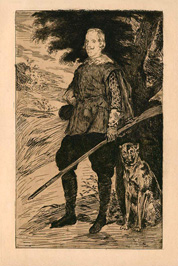Edouard
Manet
Manet
 |
Philippe
IV, Roi d'Espagne, d'après Velasquez
etching, drypoint, and aquatint, 1860 (according to Guérin)
or, more probably, 1862, on medium-weight Hollande laid
paper, with the Hallines watermark, the 4th (?) state* (of 8),
before all letters (the signature and address), a superb impression,
with rich burr on the drypoint rework (notably on the foliage
in the background and the dog), a rare trial proof, prior to
the first edition (Cadart & Chevalier 1862, i.e., the 6th
state with letters), with wide margins, an expertly repaired
50mm diagonal tear in the upper left margin, well outside the
platemark, traces of an old hinge mount along the lateral edge
on the reverse, otherwise in excellent condition
P. 355x238mm., S. 533x362mm.
